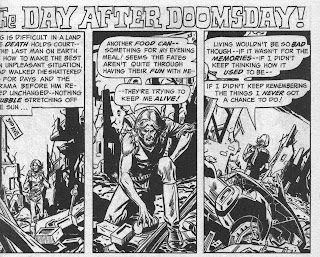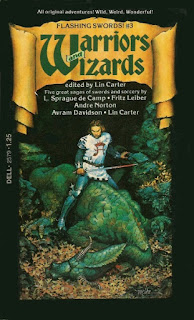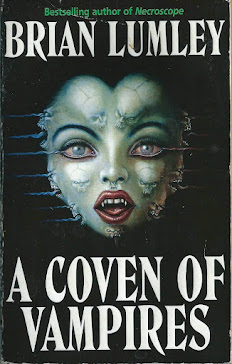DC Comics, 2014
'The Great Disaster' (575 pp) was published by DC Comics in 2014. Like all the other volumes in the 'Showcase' series, the entire contents is reproduced in black and white.
This is one of the odder compilations in the 'Showcase' series. It cobbles together comics that first were published over the 23-year interval from July 1960 to May 1983.
The overarching theme in 'Disaster' is that World War Three took place on October 9, 1986 (this date is first disclosed in an Atomic Knights tale in the September 1962 issue of Strange Adventures). This event, which periodically resurfaced among DC's comic books during the 70s and early 80s, serves as the loose thread linking all of the stories compiled in 'Disaster'.
A quarter of the contents is made up of brief 2 - 8 page stories that appeared in the anthologies Weird War Tales and The House of Secrets during the 1970s. These stories, all of which deal with a post-apocalyptic world, suffer to a some extent from being published during the Code era - the dismembered corpses and blood-drenched monsters that define post-apocalyptia in contemporary video games like Fallout 4 are utterly absent here. But the restrained plots of these short stories are compensated for, by the presence of good quality artwork, including the great Alfredo Alcala:
Along with veterans like Steve Ditko, Jack Sparling, Alex Nino, and Rich Buckler, these short stories also feature artists who would go on to become well-known in the comics world: Paul Kirchner, Frank Miller, and Howard Chaykin.
Another quarter of the book is taken up with reprinting 15 issues of Strange Adventures that appeared in 1960 - 1964 and featured the Atomic Knights.
Modern-day comic book fans are going to find the plots of these stories to be insipid, if not silly. They mainly revolve around the Knights combating various monsters and criminals infesting a post-apocalyptic USA. The one saving grace of these 'Knights' stories is the outstanding artwork by Murphy Anderson, one of the most accomplished artists of the Silver Age of comic books.
Accompanied by the by a trio of supporting characters, Hercules wanders the post-apocalyptic landscape of Europe and the USA righting wrongs and correcting injustice. There are some humorous segments showcasing contemporary social issues:
The move by DC to have only 17 pages for the lead story in its comic books at this time in the 70s means that these issues of 'Hercules' suffer from contrived, gimmicky plotting. There isn't really all that much here to recommend to modern comics readers, although the artwork - primarily done by Jose Luis Garcia-Lopez with assistance from comics great Wally Wood - is of good quality. The final issues of the series saw also some striking art by Walt Simonson, then a newcomer to the comics field.
The remaining quarter of 'The Great Disaster' is made up of a potpourri of single-issue Superman comics (one 1983 issue features a meetup of Superman, the Atomic Knights, and Hercules), some backup comics from some 1976 issues of Kamandi: The Last Boy on Earth, and even 'Atlas the Great', a Jack Kirby one-shot comic from 1975's 1st Issue Special.
Summing up, 'The Great Disaster' will appeal mainly to a Baby Boomer-based readership, who - if they remember these old comics - do so with sufficient a sense of nostalgia to overcome their bland nature. However, I doubt that readers under 40 will find much here to appeal to them.































































.jpg)
















